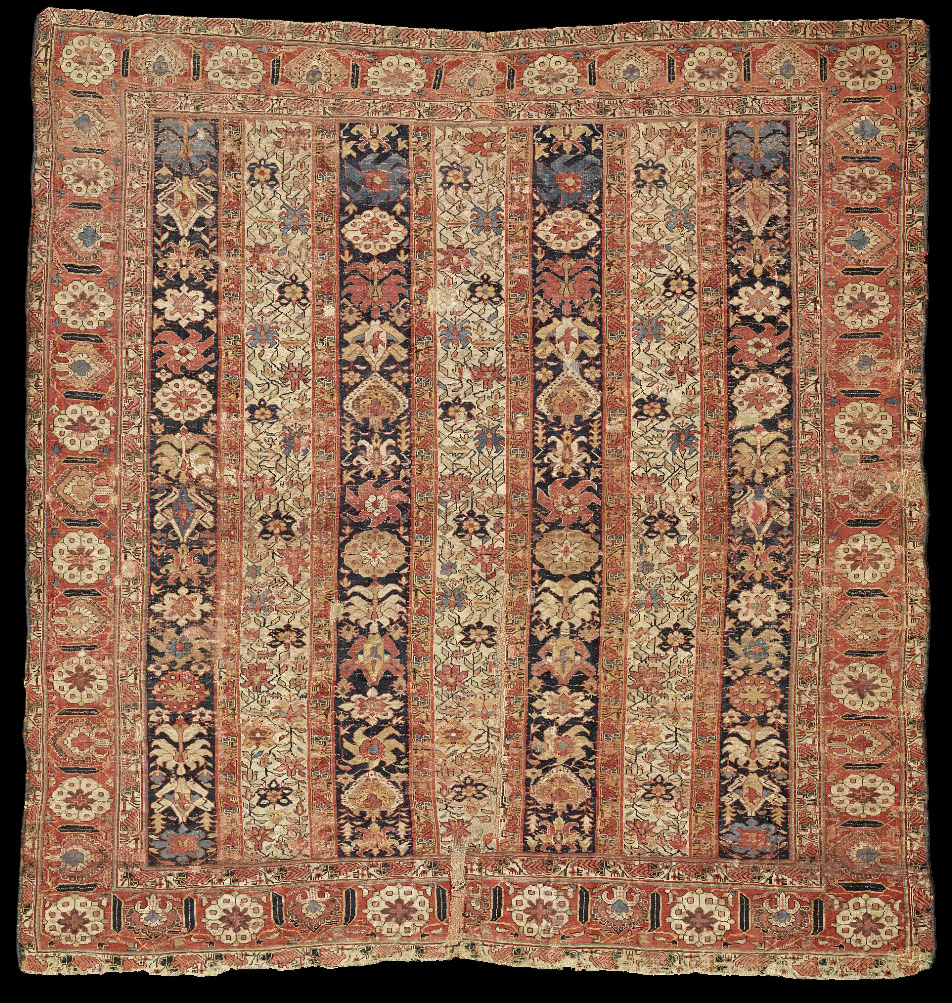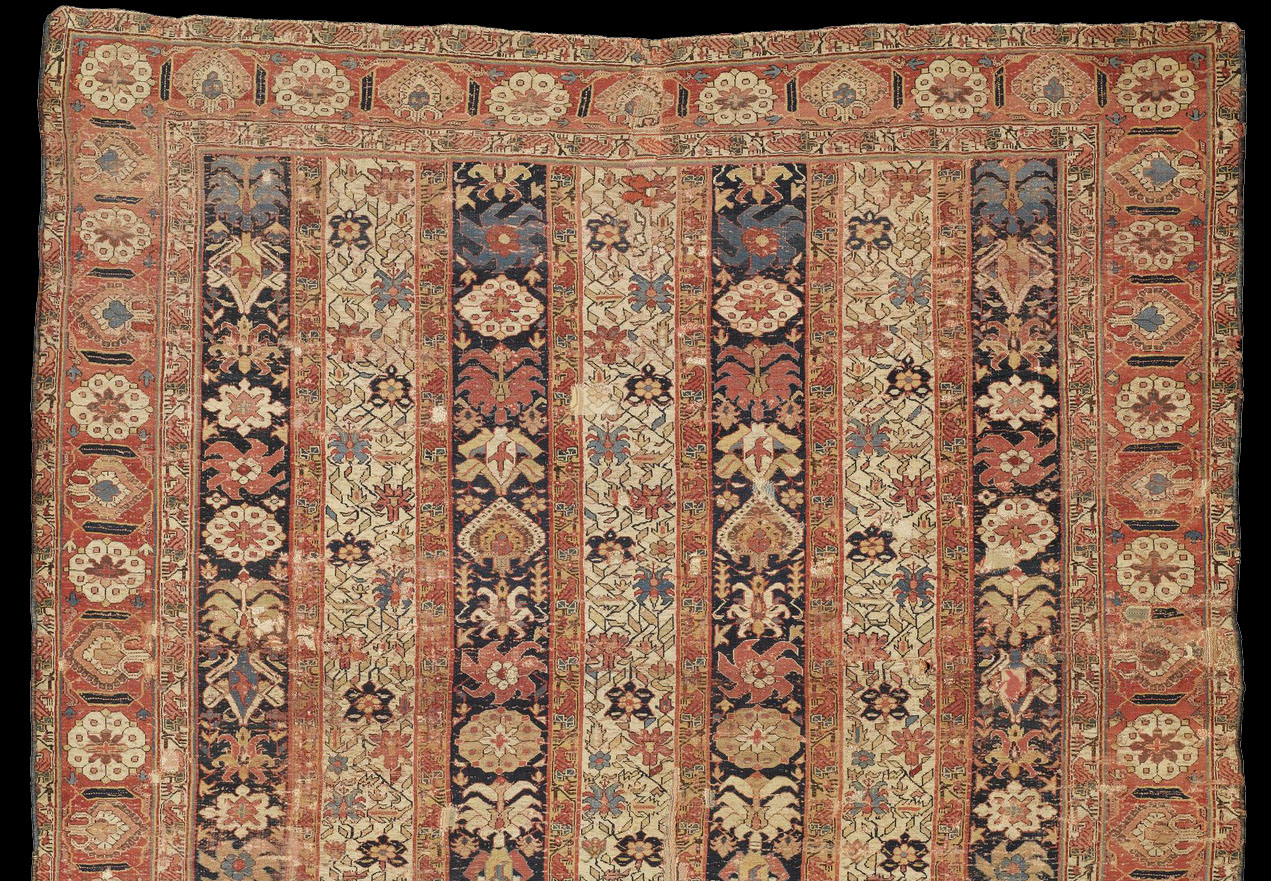|
88
A SHIRVAN MARASALI CARPET, EAST CAUCASUS,
Estimate: 20,000 - 30,000 USD
LOT SOLD. 25,000 USD (Hammer Price with Buyer's Premium)
approximately 8ft. 2in. by 7ft. 7in. (2.49 by 2.31m.)
circa 1800
Sotheby's
Carpets
New York | 25 November 2008 | N08503
TECHNICAL ANALYSIS
Warp: wool, Z3S, natural ivory
Weft: wool, Z spun, 2 shoots, madder red
Pile: wool, symmetrical knot
Density: 11 horizontal, 15 vertical
Sides: not extant
Ends: not extant
Colors: madder red, rose, mauve, aubergine, deep blue, light blue,
blue-green, green, light green, yellow, buff, walnut, ivory
CATALOGUE NOTE
This highly unusual carpet with a design of broad indigo and ivory stripes
enclosing a variety of stylized blossoms including irises, pinwheel motifs
and palmettes, may be unique in the published corpus of Caucasian rugs and
carpets. The fine weave, crisp and detailed drawing, and color palette
suggest that it was woven in the Marasali area of the Shirvan district in
the Eastern Caucasus. Here, the angularly drawn, stylized floral-motifs echo
the lilies, palmettes, and vine leafs that characterize the sophisticated
large-scale 'dragon' and 'blossom' carpets produced in the workshops of
Karabagh and Shirvan in the eighteenth and early nineteenth centuries, see
Charles Grant Ellis, Early Caucasian Rugs, Washington, D.C., 1976, pp. 71,
89 and 101. Certain design elements, such as the fan-like palmettes in the
indigo stripes of the field, exhibit classical Persian influences as these
recall those of seventeenth century Isphahan spiral-tendril carpets. The
origin of the pinwheel rosettes in alternating colors is harder to determine
with certainty but it is possible that they are modifications of medallions
found in 'Sunburst' carpets of the time, see Ellis, ibid., p. 65. Similar
pinwheel motifs also appear in Azerbaijan embroideries of the eighteenth
century such as the one illustrated in E. Heinrich Kirchheim ed., Orient
Starts, Stuttgart and London, 2003, fig 50, p. 75 and on an unusual rug sold
Rippon Boswell, Wiesbaden, 17 May 2003, lot 94. Unlike most workshop carpets
from the Caucasus, this piece is also characterized by an overall sense of
freshness in part due to the crisp ivory bands in the field. The broad use
of a light colored ground is rarely found in larger carpets and it renders
the palette of the lot offered here particularly brilliant. This brilliance
may also relate this piece to Caucasian embroideries that most often have
color compositions where crisp whites are juxtaposed with saturated reds,
blues, greens, earthy browns, and fresh yellows. Here, the contrast is not
only in hues but also in design, with the intricate flowering stem design of
the white bands juxtaposed against the bolder elements within the indigo
stripes. These flowering branches can be found in larger workshop weavings
from Karabagh and, in a more naturalistic version, also in some carpets
produced in Khorossan in the 1600s, see Kirchheim, ibid., pp. 130-131. The
border design of this carpet alternates the rosettes and palmettes found in
the field, which are separated by elongated spiked leafs. This orderly
border composition echos and complements the methodic field arrangement. The
inner and outer guard borders display highly stylized carnations that are
prototypes for those emblematic flowers that populate the borders of later
nineteenth and early twentieth century Shirvan rugs. The overall design
scheme of this carpet, including irises and fan palmettes, can be seen in a
later Shirvan rug in the Baku Museum, see Liatif Kerimov, Rugs and Carpets
from the Caucasus, Leningrad, 1984, pl. 42. Design elements in the field,
including the palmettes, and in particular the geometric lily-forms, become
more stylized and frequently used in Shirvan weavings within a century, see
Ian Bennett, Oriental Rugs, Volume 1, Caucasian, Wels, 1981, figs. 243-245,
pp. 200-201. The fine weave, modified workshop design, unusual carpet
format, and the wide color range suggest that the lot offered here is the
product of a cottage works

 |


